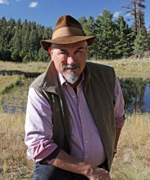 —Alan Dulaney
—Alan Dulaney
Every business must utilize resources available in the most efficient manner possible in order to lower costs and make the enterprise flourish. This is particularly true for agribusiness in Pinal County. The resource receiving the most constant attention is water, especially since the Drought Contingency Plan was negotiated.
AZ Water Association recently put on a well-attended field tour of the Maricopa Stanfield Irrigation and Drainage District (MSIDD), one of 65 irrigation districts in Arizona. Several large agricultural operations receive Colorado River water from the MSIDD via the Santa Rosa Canal, which is connected to the CAP canal. Over the years, CAP water has become more important, as it can be delivered more cheaply than pumping groundwater due to the energy cost differential. MSIDD still retains several wells, however. Most of the acreage served is farmed, but over the last few decades expanding subdivisions forced many dairies to relocate to Pinal County. MSIDD serves 11 dairies, including the two largest in Arizona. Agribusiness supports several thousand full-time jobs in Pinal County. No one wants to lose those jobs.
Farmers have accomplished a lot in terms of conserving the water they get from MSIDD, as water can be over 25% of the total cost of growing a crop. Fields have been laser leveled to insure minimal losses of irrigation water. With a zero gradient, furrows can be flooded with exactly the volume of water needed for plant growth, eliminating the waste of spray irrigation and largely eliminating runoff. Energy costs are reduced significantly, for once leveled, the fields require little additional maintenance. In some areas natural slopes are too steep to level the entire field, so bands of leveled ground separated by flattened berms create long mini-terraces to achieve the same effect. On about 30% of the farms, drip irrigation is practiced, even though it requires more energy for pumping and more maintenance to clear the lines of obstructions.
Dairies, too, conserve water through recycling. Shamrock Dairy, the largest family-owned dairy in Arizona, has almost 12,000 cows, and provides milk across the Southwest. Each cow drinks about 30–35 gallons each day, but it is in the operational cycle that water is re-used. Water first enters the operation for refrigeration purposes, and then is used again for a daily shower for each cow. It is recycled again to wash the floors of the milking and standing sheds. Solids are removed, and this water is directed to collection ponds. Mixed with irrigation water, this recycled water is applied to alfalfa and corn fields to grow feed for the cows. Groundwater is pumped from two wells under Irrigation Grandfathered Rights, but conservation / recycling is key to keeping costs in line for this large (60+ employees) agribusiness concern.
Pinal County is blessed with flat and fertile land and a long growing season that allows up to three crops per year. MSIDD points out that agriculture in this setting is about as efficient as it can get. The world is growing hungrier, and the production of food cannot always remain a lesser priority. But the growing uncertainty over the water supply has MSIDD and farmers worried. In a region where CAP supplies could be reduced as early as 2022, where the costs to pump groundwater in sufficient volumes to irrigate current acreage could make farming unsustainable, and where it is always, always warmer and drier, the only certainty is that agribusiness in Pinal County at the end of the next decade will not look like it does today.